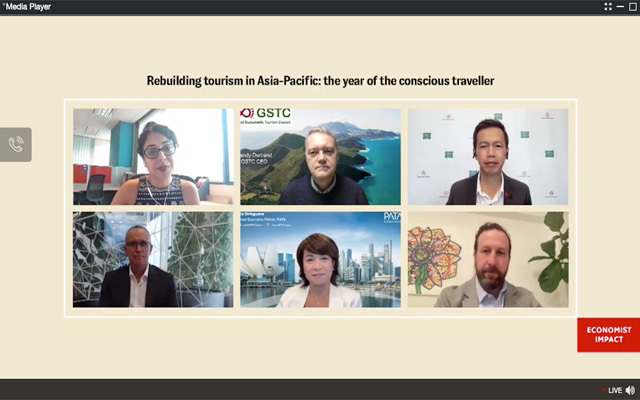The pandemic has intensified travellers and organisations’ awareness of sustainable tourism but it remains to be seen if that consciousness will translate into action and responsible travel demand, say industry leaders on the Rebuilding tourism in Asia-Pacific: The year of the conscious traveller webinar.
In a recent Economist Impact survey of more than 4,500 travellers in Asia-Pacific, more than seven in 10 respondents indicate that Covid-19 has changed the way they think about sustainable tourism by making it more important to them.

Randy Durband, chief executive, Global Sustainable Tourism Council (GSTC), said: “I think we are on the dawn of a new traveller. We’re seeing an increasing amount of consciousness, (but not) what actually happens with behaviour. While there will not be a revolution, we are going to see significant changes (as to how people approach travel).”
Durband related an example of a group of American travellers who overwhelmingly stated Hawaii as their dream destination but eventually went to Florida or Mexico because of “bargains or discounts”.
Liz Ortiguera, CEO of PATA, said cost concerns could influence socially-conscious travel decisions.
Keith Tan, chief executive, Singapore Tourism Board, opined that sustainable travel demand is also reliant on supply. “We saw (sustainable travel demand) before the pandemic, but they were very scattered. A question now for NTOs is how we can harness and grow this momentum to support the supply side, so that this dawn can become a new era,” he said.
And with more destinations reopening for travel, Ortiguera said there was a responsibility on all sides to find ways to welcome tourism back without overwhelming the system.
Building tourism back better, according to John Lee, director-general, department of tourism, innovation and sport with the Queensland government, requires the alleviation of overtourism in certain destinations in Asia.
Theo Yedinsky, Airbnb’s global policy director, however, posited that the diffusion of tourism is already happening, and smaller towns now have “a level of economic opportunity out of the tourism industry they had not had before”.
“It is an amazing time (for NTOs to do) good old fashion storytelling about the opportunities that are out there and the places to go to, as people will be very open to hearing about them,” he said.
Another silver lining from the pandemic is the heightened awareness of technology and digitalisation, and its accelerated adoption.
Citing examples, Tan said Singapore tourism stakeholders have used digital tools to reduce risky human interactions while hotels are relying on technology to cut food waste.
“On the consumer side, there are also apps that support consumer decision-making, whether it helps make them more conscious of their carbon footprint, or where they can source sustainable food choices, clothing, or activities,” Ortiguera added.
However, aviation remains a major hinderance to the progress of sustainable tourism, as the industry is still years away from cleaner fuel sources.
“Travel and tourism is dependent on aviation. The flight shame movement was growing before the pandemic, and with climate change punching us in the face, that’s going to come back. We are probably 15 years away from reasonably clean aviation, so that puts tourism business at tremendous risk,” Durband remarked.
Lee expected the pandemic to move key airlines towards smarter route development, “where they can find a niche in which they can operate to their benefit”.
However, the reality is that the market currently favours mass travel and connections, such as the Sydney-Melbourne route that was top five in volume pre-pandemic.
“Major primary routes will always be lower cost unit than secondary tertiary routes”, said Durband, who suggested that NTOs could promote more flights to secondary markets, or air over rail as rail is greener.
As to how governments and business leaders can ensure that travel recovery is more sustainable, speakers say clear standards and expectations must be set, and a systematic approach must be taken.
Tan pointed out that as an NTO, it was important to think about “what sort of grants and incentives can be used to support and nudge tourism stakeholders” towards Global Sustainable Tourism Council’s standards and goals.
However, many of such sustainable initiatives, and the progress and commitments by government organisations, may not be visible to the everyday traveller. As such, Tan highlighted the need to make efforts more “visible” to the conscious traveller who may be willing to pay more for a sustainable hotel or attend a net-zero event.




















